
April showers might bring May flowers, but you still should be wary of the storm before you get to the sunshine. Rain doesn’t always mean a storm, but whether it’s drizzling or a full-on downpour, you want to be prepared before you get behind the wheel on a rainy spring day. There are lots of tips you can use for driving in bad weather.
Before You Drive
Before you start driving in bad weather, knowing how wet the roads are and the possible lack of visibility could help you drive safer. You always have the option to wait until the weather conditions improve before hitting the road. If you don’t feel comfortable driving in the rain, wait until the weather improves. Driving while nervous or scared can become a danger to you and others on the road.
Always check your vehicle’s equipment on a regular basis, even when the weather isn’t bad. Make sure you check all the essentials, like your headlights, taillights and windshield Wipers. Those three important parts could mean the difference between a safe drive and an unsafe one. Also, check the tread of your vehicle’s tires to ensure they are not bald. Bald tires significantly reduce traction.
You might also like: DIY Mother’s Day Gifts For The Kids
While You’re Driving
Sometimes, you get caught in bad weather while you’re driving and waiting it out isn’t an option. In this case, there are many tips you can use to keep your ride safe. Slowing down is an important tip. It may seem small, but this makes a huge difference. Driving at the speed limit or slower is the safest option. Rain slows down your vehicles’ reaction time. Therefore, by reducing your speed, you have more reaction time.
Make sure your headlights are on when driving in rainy weather. Even during the day, it can get dark, and your headlights let other cars on the road know you are there. In addition to your headlights, keeping a safe distance between the cars in front of you will also help you gain more reaction time. You should use several car lengths between your car and the one in front of you.
The previous two tips will help you with the next one, which is to avoid heavy braking. Depending on the roads you are driving on, there could be spots of standing water. Standing water can cause hydroplaning and heavy braking. If you do hydroplane, do not intensely gas or brake the vehicle. Calmly take your foot off the accelerator and steer in the direction you need to go. Avoid sudden turns.
Disclaimer: The stock image is being used for illustrative purposes only, and it is not a direct representation of the business, recipe, or activity listed. Any person depicted in the stock image is a model.
